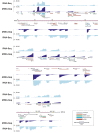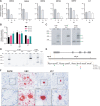The architecture of the simian varicella virus transcriptome
- PMID: 34807956
- PMCID: PMC8648126
- DOI: 10.1371/journal.ppat.1010084
The architecture of the simian varicella virus transcriptome
Abstract
Primary infection with varicella-zoster virus (VZV) causes varicella and the establishment of lifelong latency in sensory ganglion neurons. In one-third of infected individuals VZV reactivates from latency to cause herpes zoster, often complicated by difficult-to-treat chronic pain. Experimental infection of non-human primates with simian varicella virus (SVV) recapitulates most features of human VZV disease, thereby providing the opportunity to study the pathogenesis of varicella and herpes zoster in vivo. However, compared to VZV, the transcriptome and the full coding potential of SVV remains incompletely understood. Here, we performed nanopore direct RNA sequencing to annotate the SVV transcriptome in lytically SVV-infected African green monkey (AGM) and rhesus macaque (RM) kidney epithelial cells. We refined structures of canonical SVV transcripts and uncovered numerous RNA isoforms, splicing events, fusion transcripts and non-coding RNAs, mostly unique to SVV. We verified the expression of canonical and newly identified SVV transcripts in vivo, using lung samples from acutely SVV-infected cynomolgus macaques. Expression of selected transcript isoforms, including those located in the unique left-end of the SVV genome, was confirmed by reverse transcription PCR. Finally, we performed detailed characterization of the SVV homologue of the VZV latency-associated transcript (VLT), located antisense to ORF61. Analogous to VZV VLT, SVV VLT is multiply spliced and numerous isoforms are generated using alternative transcription start sites and extensive splicing. Conversely, low level expression of a single spliced SVV VLT isoform defines in vivo latency. Notably, the genomic location of VLT core exons is highly conserved between SVV and VZV. This work thus highlights the complexity of lytic SVV gene expression and provides new insights into the molecular biology underlying lytic and latent SVV infection. The identification of the SVV VLT homolog further underlines the value of the SVV non-human primate model to develop new strategies for prevention of herpes zoster.
Conflict of interest statement
The authors have declared that no competing interests exist.
Figures










Similar articles
-
Comparative Analysis of the Simian Varicella Virus and Varicella Zoster Virus Genomes.Viruses. 2022 Apr 19;14(5):844. doi: 10.3390/v14050844. Viruses. 2022. PMID: 35632586 Free PMC article. Review.
-
Acute Simian Varicella Virus Infection Causes Robust and Sustained Changes in Gene Expression in the Sensory Ganglia.J Virol. 2016 Nov 14;90(23):10823-10843. doi: 10.1128/JVI.01272-16. Print 2016 Dec 1. J Virol. 2016. PMID: 27681124 Free PMC article.
-
Attenuation of Simian Varicella Virus Infection by Enhanced Green Fluorescent Protein in Rhesus Macaques.J Virol. 2018 Mar 14;92(7):e02253-17. doi: 10.1128/JVI.02253-17. Print 2018 Apr 1. J Virol. 2018. PMID: 29343566 Free PMC article.
-
The ORF61 Protein Encoded by Simian Varicella Virus and Varicella-Zoster Virus Inhibits NF-κB Signaling by Interfering with IκBα Degradation.J Virol. 2015 Sep;89(17):8687-700. doi: 10.1128/JVI.01149-15. Epub 2015 Jun 17. J Virol. 2015. PMID: 26085158 Free PMC article.
-
Simian varicella virus: molecular virology.Curr Top Microbiol Immunol. 2010;342:291-308. doi: 10.1007/82_2010_27. Curr Top Microbiol Immunol. 2010. PMID: 20369316 Free PMC article. Review.
Cited by
-
Identification of herpesvirus transcripts from genomic regions around the replication origins.Sci Rep. 2023 Sep 29;13(1):16395. doi: 10.1038/s41598-023-43344-y. Sci Rep. 2023. PMID: 37773348 Free PMC article.
-
Comparative Transcriptomics Analysis of Foot-and-Mouth Disease Virus-Infected Cell Model Systems.Vet Sci. 2025 Feb 1;12(2):107. doi: 10.3390/vetsci12020107. Vet Sci. 2025. PMID: 40005867 Free PMC article.
-
Comparative Analysis of the Simian Varicella Virus and Varicella Zoster Virus Genomes.Viruses. 2022 Apr 19;14(5):844. doi: 10.3390/v14050844. Viruses. 2022. PMID: 35632586 Free PMC article. Review.
-
Nanopore Guided Annotation of Transcriptome Architectures.bioRxiv [Preprint]. 2024 Apr 3:2024.04.02.587744. doi: 10.1101/2024.04.02.587744. bioRxiv. 2024. Update in: mSystems. 2024 Jul 23;9(7):e0050524. doi: 10.1128/msystems.00505-24. PMID: 38617228 Free PMC article. Updated. Preprint.
-
Nanopore guided annotation of transcriptome architectures.mSystems. 2024 Jul 23;9(7):e0050524. doi: 10.1128/msystems.00505-24. Epub 2024 Jul 2. mSystems. 2024. PMID: 38953320 Free PMC article.
References
Publication types
MeSH terms
Substances
Grants and funding
LinkOut - more resources
Full Text Sources

